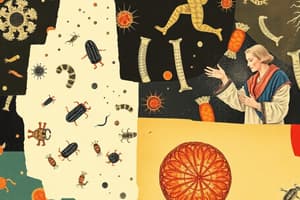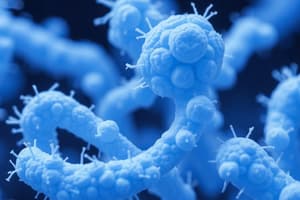Podcast
Questions and Answers
During which time period is considered the first golden age of microbiology?
During which time period is considered the first golden age of microbiology?
- Early 20th century
- Late 19th century (correct)
- After the 1950s
- Today
What is the most important microbial group in foods?
What is the most important microbial group in foods?
Bacteria
Viruses reproduce outside of host cells.
Viruses reproduce outside of host cells.
False (B)
Yeast reproduce asexually through a process called ____________.
Yeast reproduce asexually through a process called ____________.
Match the fungal genus with its food spoilage characteristics:
Match the fungal genus with its food spoilage characteristics:
What is the passing grade for the course FOOD-8046 Food Microbiology?
What is the passing grade for the course FOOD-8046 Food Microbiology?
What are the evaluation components in the FOOD-8046 Food Microbiology course? (Select all that apply)
What are the evaluation components in the FOOD-8046 Food Microbiology course? (Select all that apply)
To pass the course FOOD-8046 Food Microbiology, students must have an attendance of __% to lab practices.
To pass the course FOOD-8046 Food Microbiology, students must have an attendance of __% to lab practices.
Match the following learning outcomes with the correct description:
Match the following learning outcomes with the correct description:
Which major group of microorganisms is considered the largest and most important in food spoilage and foodborne illness?
Which major group of microorganisms is considered the largest and most important in food spoilage and foodborne illness?
Bacteria reproduce by ____________ with varying reproduction rates.
Bacteria reproduce by ____________ with varying reproduction rates.
Fungi like yeast are resistant to adverse conditions such as high osmolarity, acidic pH, and low water activity.
Fungi like yeast are resistant to adverse conditions such as high osmolarity, acidic pH, and low water activity.
How much is the passing grade for the course FOOD-8046 Food Microbiology?
How much is the passing grade for the course FOOD-8046 Food Microbiology?
Which components contribute to the evaluation summary of the course FOOD-8046 Food Microbiology? (Select all that apply)
Which components contribute to the evaluation summary of the course FOOD-8046 Food Microbiology? (Select all that apply)
Microorganisms are visible to the naked eye.
Microorganisms are visible to the naked eye.
The name given to the unique features of viruses are ________.
The name given to the unique features of viruses are ________.
Match the following individuals with their contributions in the field of Food Microbiology:
Match the following individuals with their contributions in the field of Food Microbiology:
Flashcards are hidden until you start studying
Study Notes
Food Microbiology
- Food Microbiology is a course that covers the study of microorganisms in food, including their role in food spoilage, foodborne illness, and fermentation.
Instructor Information
- Instructor: José Gabrie
- Contact information: [email protected] (email), no phone number or office hours listed.
Evaluation Summary
- The course has a passing grade of 60%.
- Evaluation consists of:
- Midterm exam 1 (Lectures & Labs): 20%
- Midterm exam 2 (Lectures & Labs): 20%
- Lab reports: 20%
- Final exam (comprehensive): 40%
Laboratory Practices
- Attendance: ≥ 80% attendance to lab practices is mandatory to pass the course.
- Lab activities cannot be repeated due to the nature of the lessons.
- Participation during lab practices will enhance learning.
Code of Conduct
- Expectations include:
- Punctuality
- Participative in lectures
- Polite and respectful to others
- Listening courteously when others are talking
- Respecting others' opinions
- Prepared for class and labs
- Truthful and honest (Academic integrity policy)
Study Tips
- Take notes during class, as not everything is on the slides or guides.
- Buy a Laboratory Notebook, which is a mandatory requirement.
Key Considerations
- Marks are not given by the instructor, but earned by the students.
- Failing this course will impact the second semester, as it is a pre-requisite for FOOD 8080 and FOOD 8090.
Supplemental Exam Eligibility Criteria
- Minimum final grade of 55% is required.
- Must have passed at least one major evaluation (midterm or final exam).
- Must have attended at least 80% of lectures.
- Must not have filed for academic misconduct.
- Additional requirements may apply.
Introduction to Food Microbiology
- Microorganisms are very small and cannot be seen with the naked eye.
- Types of microorganisms: viruses, bacteria, protozoa, fungi (yeasts and moulds).
- Microorganisms are ubiquitous, found in humans, animals, plants, soil, water, and atmosphere.
Discovery of Microorganisms
- The discovery of microorganisms ran parallel to the invention and improvement of the microscope.
- Key figures in the discovery of microorganisms: Antonie van Leeuwenhoek, Robert Hooke, and Athanasius Kircher.
Microorganisms in Food
- Microorganisms are present in food and play a role in food spoilage, foodborne illness, and fermentation.
- Desirable role of microorganisms: fermentation.
- Undesirable role of microorganisms: spoilage and foodborne illness.
Classification and Naming of Organisms
- Linnaean Taxonomy (binominal system) is used to classify and name organisms.
- Domain, Kingdom, Phylum, Class, Order, Family, Genus, Species.
Food Microbiology Timeline
- Early humans: assumed awareness of food spoilage and foodborne illness.
- 1000 BC - 1600 AD: people recognized an association between diseases and some foods.
- 1600s - 1800s: discovery of microorganisms, rise of spontaneous generation theory.
- 1800s - 1900s: development of food microbiology, discovery of microorganisms in food spoilage and foodborne illness.
- 20th century: expansion of food microbiology, development of fermentation science.
Characteristics of Microorganisms
- Bacteria: unicellular, prokaryotes, no nucleus, reproduce by binary fission.
- Yeast: unicellular, eukaryotes, reproduce by budding.
- Molds: multicellular, filamentous fungi, reproduce by asexual spores.
- Viruses: non-cellular, reproduce inside host cells.
Fungi (Yeasts)
- Yeasts are important in food because of their ability to cause spoilage of acidic and high sugar content foods.
- Examples of yeast genera: Saccharomyces, Torulopsis, Candida.
Fungi (Molds)
- Molds are multicellular, filamentous fungi that grow on foods.
- Examples of mold genera: Aspergillus, Penicillium, Fusarium.
- Molds can produce mycotoxins.
Bacteria
- Bacteria are unicellular, prokaryotes that can be motile or non-motile.
- They can produce endospores for survival and spreading.
- Different growing conditions are required for different bacteria.
Food Microbiology
- Food Microbiology is a course that covers the study of microorganisms in food, including their role in food spoilage, foodborne illness, and fermentation.
Instructor Information
- Instructor: José Gabrie
- Contact information: [email protected] (email), no phone number or office hours listed.
Evaluation Summary
- The course has a passing grade of 60%.
- Evaluation consists of:
- Midterm exam 1 (Lectures & Labs): 20%
- Midterm exam 2 (Lectures & Labs): 20%
- Lab reports: 20%
- Final exam (comprehensive): 40%
Laboratory Practices
- Attendance: ≥ 80% attendance to lab practices is mandatory to pass the course.
- Lab activities cannot be repeated due to the nature of the lessons.
- Participation during lab practices will enhance learning.
Code of Conduct
- Expectations include:
- Punctuality
- Participative in lectures
- Polite and respectful to others
- Listening courteously when others are talking
- Respecting others' opinions
- Prepared for class and labs
- Truthful and honest (Academic integrity policy)
Study Tips
- Take notes during class, as not everything is on the slides or guides.
- Buy a Laboratory Notebook, which is a mandatory requirement.
Key Considerations
- Marks are not given by the instructor, but earned by the students.
- Failing this course will impact the second semester, as it is a pre-requisite for FOOD 8080 and FOOD 8090.
Supplemental Exam Eligibility Criteria
- Minimum final grade of 55% is required.
- Must have passed at least one major evaluation (midterm or final exam).
- Must have attended at least 80% of lectures.
- Must not have filed for academic misconduct.
- Additional requirements may apply.
Introduction to Food Microbiology
- Microorganisms are very small and cannot be seen with the naked eye.
- Types of microorganisms: viruses, bacteria, protozoa, fungi (yeasts and moulds).
- Microorganisms are ubiquitous, found in humans, animals, plants, soil, water, and atmosphere.
Discovery of Microorganisms
- The discovery of microorganisms ran parallel to the invention and improvement of the microscope.
- Key figures in the discovery of microorganisms: Antonie van Leeuwenhoek, Robert Hooke, and Athanasius Kircher.
Microorganisms in Food
- Microorganisms are present in food and play a role in food spoilage, foodborne illness, and fermentation.
- Desirable role of microorganisms: fermentation.
- Undesirable role of microorganisms: spoilage and foodborne illness.
Classification and Naming of Organisms
- Linnaean Taxonomy (binominal system) is used to classify and name organisms.
- Domain, Kingdom, Phylum, Class, Order, Family, Genus, Species.
Food Microbiology Timeline
- Early humans: assumed awareness of food spoilage and foodborne illness.
- 1000 BC - 1600 AD: people recognized an association between diseases and some foods.
- 1600s - 1800s: discovery of microorganisms, rise of spontaneous generation theory.
- 1800s - 1900s: development of food microbiology, discovery of microorganisms in food spoilage and foodborne illness.
- 20th century: expansion of food microbiology, development of fermentation science.
Characteristics of Microorganisms
- Bacteria: unicellular, prokaryotes, no nucleus, reproduce by binary fission.
- Yeast: unicellular, eukaryotes, reproduce by budding.
- Molds: multicellular, filamentous fungi, reproduce by asexual spores.
- Viruses: non-cellular, reproduce inside host cells.
Fungi (Yeasts)
- Yeasts are important in food because of their ability to cause spoilage of acidic and high sugar content foods.
- Examples of yeast genera: Saccharomyces, Torulopsis, Candida.
Fungi (Molds)
- Molds are multicellular, filamentous fungi that grow on foods.
- Examples of mold genera: Aspergillus, Penicillium, Fusarium.
- Molds can produce mycotoxins.
Bacteria
- Bacteria are unicellular, prokaryotes that can be motile or non-motile.
- They can produce endospores for survival and spreading.
- Different growing conditions are required for different bacteria.
Studying That Suits You
Use AI to generate personalized quizzes and flashcards to suit your learning preferences.




